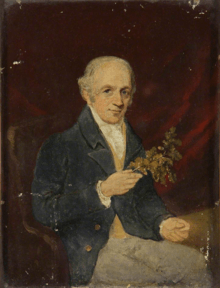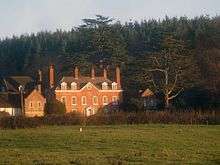Thomas Andrew Knight
| Thomas Andrew Knight | |
|---|---|
.jpg) Thomas Andrew Knight, portrait by Solomon Cole (1806–1893), collection of Royal Botanic Gardens, Kew | |
| Born |
12 August 1759 Wormsley Grange, Herefordshire, England |
| Died |
11 May 1838 London, England |
| Residence | Elton Hall and Downton Castle, Herefordshire |
| Nationality | English |
| Children |
Frances Acton |
| Scientific career | |
| Fields | botanist |
| Author abbrev. (botany) | T.Knight |

Thomas Andrew Knight (1759–1838), FRS, of Elton Hall in the parish of Elton in Herefordshire (4 miles south-west of Ludlow) and later of Downton Castle (3 miles north-west of Elton), was a horticulturalist and botanist. He served as the 2nd President of the Royal Horticultural Society (1811–1838).
Origins
_Arms.png)
He was born at Wormesley Grange, five miles north-west of Hereford in Herefordshire, the second son of Rev. Thomas Knight (1697–1764) of Wormsley Grange, Rector of Bewdley, Worcestershire, by his wife Ursula Nash, a daughter of Frederick Nash of Dinham, Shropshire.[2] He was the heir of his unmarried elder brother the art connoisseur Payne Knight (1750–1824), MP, who had been the heir not only of their father but also of their uncle Richard II Knight (1693–1765) of Croft Castle and of Downton, and who had re-built Downton Hall as the surviving Gothic revival style Downton Castle.[3] Richard II Knight as the eldest of five sons was the heir of his father Richard I Knight (1659–1745), of Downton, a wealthy ironmaster of Bringewood Ironworks,[4][5] on the Downton estate, who founded the family's great fortune.[6]
Career

He attended Balliol College, Oxford. After graduation, he took up the study of horticulture. Attention was first called to his work in 1795 by the publication of the results of his research into the propagation of fruit trees and the diseases prevalent among them.[7] He used 10,000 acres (4,000 ha) of land he inherited to conduct breeding of plants including strawberries, cabbages and peas and built an extensive greenhouse. In 1797 he published his Treatise on the Culture of the Apple and Pear, and on the Manufacture of Cider and Perry, a work which passed through several editions.[8] He was one of the leading students of horticulture in the eighteenth and nineteenth centuries, but his personal papers disappeared after his death.
Knight performed basic physiological experiments on plants, which work had been performed before only rarely. He elucidated the effects of gravity on seedlings and how decay in fruit trees was passed on by grafting. In many respects his work looked back to that of Rev. Stephen Hales. His goals were always strictly practical, aiming to improve useful food plants by breeding for better qualities. The Downton strawberry was the ancestor of most important modern strawberries until recent times.
It is not widely known that he studied variation in peas and found many of the same results as Mendel, but he failed to make the same imaginative leap about how these changes took place.[9] Knight intentionally shut himself off from outside scientific influences. He refused to read anyone else's scientific papers until Sir Joseph Banks, with whom he had a voluminous correspondence, persuaded him to do so. Knight reported on all his work in the Transactions of the Royal Society of London.
From 1811 to 1838 Knight was president of the London Horticultural Society, founded in 1804. Banks, president of the Royal Society, had recognised Knight's striking contributions to science and prevailed upon him to join the Horticultural Society, as it was then known. After the death of the first president, George Legge, 3rd Earl of Dartmouth, Banks proposed Knight to be president. In 1864 the Society received a royal patent from Albert, Prince Consort, which permitted it to be known thenceforth as the Royal Horticultural Society. Banks called upon Knight to write a "prospectus" for the society (what would now be called a mission statement), outlining its functions and purpose.
Younger members of the Society were inspired by his example. Men such as Thomas Laxton carried on his principles of careful observation and practical goals. Laxton left as his legacy improved varieties of apples, peas and sweet peas among many others, together with a thriving seed business.
Marriage and progeny
He married Frances Felton, a daughter of Humphry Felton of Woodhall in Shropshire, by whom he had progeny as follows:[10]
- Thomas Andrew Knight (d.29 November 1827), eldest son and heir apparent, who predeceased his father without issue.
- Frances Knight (d.1874), a botanist, archaeologist, writer and artist, who in 1812 married Thomas Pendarves Stackhouse Acton (d.1835) of Acton Scott; without progeny.
- Elizabeth Knight (d. 3 August 1860), who in 1828 married Francis Walpole (d.1861), son of Hon. Robert Walpole, son of Horatio Walpole, 1st Baron Walpole of Wolterton, brother of Robert Walpole, 1st Earl of Orford (1676–1745), first Prime Minister of Great Britain. With progeny.
- Charlotte Knight (c.1801–14 May 1842), a notable horticulturalist, who in 1824 married Sir William Edward Rouse-Boughton, 2nd and 10th Baronet (1788–1856), a member of parliament for Evesham in Worcestershire. She was the heiress of her father's Downton Castle estate, although the inheritance was unsuccessfully contested by her senior male cousin (John Knight (1765–1850),[11] of Lea Castle, Wolverley, the pioneering developer of the Forest of Exmoor in Somerset) in the lengthy and famous law suit of Knight v Knight (1836–40).
Death and burial
He died in 1838 and was buried in the churchyard of St Mary's Church, Wormsley,[12] where his surviving chest tomb is a grade II listed structure.[13]
See also
- Knight v Knight (1840) 3 Beav 148
Notes
- ↑ Burke's Genealogical and Heraldic History of the Landed Gentry, 15th Edition, ed. Pirie-Gordon, H., London, 1937, p.1306, pedigree of Rouse-Boughton-Knight of Downton Castle, 1st quarter. Blazoned similarly for their cousins Knight of Wolverley, Worcestershire, in: Victoria County History, Worcestershire, Vol.3, 1913, Parishes: Wolverley, pp.567–573 as: Argent, three pales gules in a bordure engrailed azure on a quarter gules a spur or (Victoria County History, Worcestershire, Vol.3, 1913, Parishes: Wolverley, pp.567–573)
- ↑ History of Parliament biography of his brother Richard Payne Knight
- ↑ History of Parliament biography of his brother Richard Payne Knight
- ↑ Ince, L., The Knight family and the British iron industry 1695–1902 (1991), 6
- ↑ R. Page, 'Richard and Edward Knight: ironmasters of Bringewood and Wolverley' Transactions of Woolhope Naturalists' Field Club 43 (1979), 15.
- ↑ Thomas Andrew Knight's inheritance from his brother Payne Knight was discussed in great detail by the judge in the case of Knight v Knight (1840)
- ↑

- ↑

- ↑ Zirkle, Conway. (1951). Gregor Mendel & His Precursors. Isis. Vol. 42, No. 2, pp. 97–104.
- ↑ Burke's Genealogical and Heraldic History of the Landed Gentry, 15th Edition, ed. Pirie-Gordon, H., London, 1937, p.1305, pedigree of Knight of Wolverley
- ↑ Burke's Genealogical and Heraldic History of the Landed Gentry, 15th Edition, ed. Pirie-Gordon, H., London, 1937, p.1305, pedigree of Knight of Wolverley
- ↑ St Mary, Wormsley, Churches Conservation Trust, archived from the original on 18 February 2011, retrieved 21 October 2010
- ↑ "Thomas Andrew Knight Monument about 15 yards northeast of the northeast corner of the Church of St Mary, Brinsop and Wormsley", Heritage Gateway website, Heritage Gateway (English Heritage, Institute of Historic Building Conservation and ALGAO:England), 2006, retrieved 21 October 2010
- ↑ IPNI. T.Knight.
References
- Fletcher, H.R. 1969, The Story of the Royal Horticultural Society 1804 -1968, Oxford and London, Oxford University Press for the Royal Horticultural Society, (Portrait facing page 52)
External links
- USDA
- Ohio state
- "Knight, Thomas Andrew, Esq. F.R.S.". Biographical Dictionary of the Living Authors of Great Britain and Ireland. 1816. p. 192.